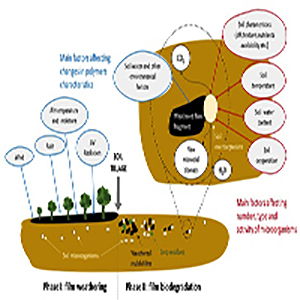Evaluation of the mulch films biodegradation in soil: A methodological review

Accepted: 28 October 2021
HTML: 584
All claims expressed in this article are solely those of the authors and do not necessarily represent those of their affiliated organizations, or those of the publisher, the editors and the reviewers. Any product that may be evaluated in this article or claim that may be made by its manufacturer is not guaranteed or endorsed by the publisher.
Plastic mulch films are widely used in agriculture, but most are not biodegradable in soil. Biodegradable mulch films are blends of different polymers whose composition ratios vary notably from one product to another. Their degradation rates vary significantly according to the physio-chemical characteristics of the product and according to the properties of the soil and its microbial activity. This review aims to provide an overview of the methods used to estimate the biodegradation performances of biodegradable plastics in the soil. In line with this objective, 80 papers were selected and systematically analysed to extract information on the characteristics of the soil used in the experiments, the type of polymer analysed, and the methods used to estimate biodegradation in the soil environment. Our systematic analysis showed that studies were carried out under both laboratory-controlled and open-field conditions, with different approaches involving visual analysis, mass loss measurements, spectroscopy, and CO2 measurements. Linear estimation of biodegradation performance for four of the most common biodegradable polymers (i.e., polybutylene succinate, polybutylene succinate-co-adipate, polylactic acid, and polybutylene adipate-co-terephthalate), either pure or blended, showed an extensive range of results that appear only partially comparable. Furthermore, many of the analysed papers did not report soil characteristics at all, despite soil being one of the most important factors in the biodegradation process. Although methodologies for estimating biodegradation are well developed, at least under laboratory-controlled conditions, there is a need for a shared methodology to make results comparable among different experiments. Within such a shared methodology, visual analysis or mass loss measurements, despite not being able to prove the biodegradation of polymers scientifically, should not be discarded a priori as they might be valuable indicators, especially for open-field experiments. When using indirect biodegradation indicators such as visual analysis or mass loss, it is necessary to couple them with CO2 measurements or use materials whose biodegradability in the soil environment has already been tested.
Highlights
- Most of the analysed studies were carried out under laboratory conditions.
- Biodegradation was primarily estimated by indirect methods (visual analysis, mass loss, and spectroscopy).
- Despite being a key factor in biodegradation, soil characteristics were not described in many papers.
- Indirect methods can be useful indicators for open field studies, but they cannot prove the biodegradation of materials.
- Indirect methods should always be coupled with direct methods (CO2 evolution) or using films proved to be biodegradable in soil.
How to Cite

This work is licensed under a Creative Commons Attribution-NonCommercial 4.0 International License.
PAGEPress has chosen to apply the Creative Commons Attribution NonCommercial 4.0 International License (CC BY-NC 4.0) to all manuscripts to be published.

 https://doi.org/10.4081/ija.2021.1936
https://doi.org/10.4081/ija.2021.1936



